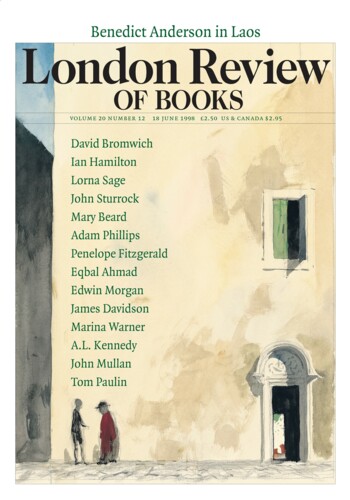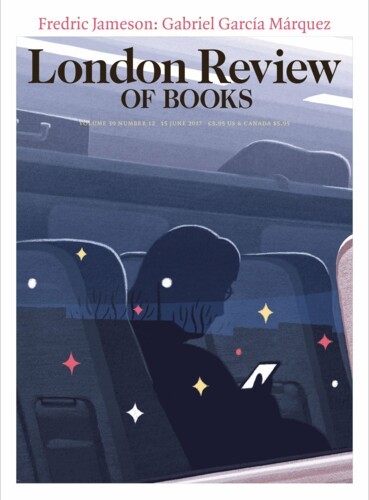These handsome volumes contain the last remains of Katherine Mansfield: a full and final transcription of the amorphous mass of hopeful notes, dissatisfied jottings, bad poems, sick scribbles, lists, sums and drafts, some dating back to her youth, which she left behind when she died in January 1923. All her bits and pieces are here, chronologically arranged and beautifully bound, with a picture of the cheap exercise books she used on the cover, their faded marbled fronts transformed into a bookish reliquary.
This was the material John Middleton Murry mined for the selections he called the Journal and the Scrapbook, though it’s long been known that there was no such distinction. Margaret Scott, who is also co-editor of the five-volume Mansfield Collected Letters, has worked for years on these Mansfield papers at the Turnbull Library in Wellington, New Zealand, where most of them are kept (the rest are in Chicago), and where she was a librarian. The long toil involved in deciphering their unreliable handwriting and arcane order must suggest a labour of love. Is Ms Scott perhaps the archival equivalent of Mansfield’s much abused lady minder ‘L.M.’ (Ida Baker)? Not in the least. Some of Mansfield’s own witty and acerbic tone seems to have rubbed off on her. She takes a cool pleasure in pointing out, for instance, that one of the mots Murry salvaged – ‘Spring comes with exquisite effort in England’ – actually reads ‘Spring comes with exquisite effect
In the early notebooks she was scribbling so fast that the only form of punctuation she used was a dash. A dash was quicker and easier to make than a backward-turning comma or a stationary full stop. As she wrote, at top speed, and ‘heard’ the need for a pause she employed a dash. Since many of these dashes function as commas or full stops I have rendered them so.
Where Murry supplied exclamation marks and question-marks to dramatise Mansfield’s fervour, Scott renders her merely clear, wherever possible. This makes sense: these notebooks were not used to articulate an ‘inner’ rhythm, they were not another kind of writing – writing about writing – but a means to the end of work in the world.
More than anything Mansfield wanted to be an artist in the public sense. If the notebooks have an inward and reflexive dimension it’s because for most of Volume I, which takes us up to 1914, she was an adolescent and an apprentice – ‘I have a perfectly frantic desire to write something really fine, and an inability to do so which is infinitely distressing’ (1908) – and for much of Volume II, which covers the years until her death, she was ill with TB, and often artificially and unwillingly isolated. In fact, one of the most interesting aspects of her jottings is that they question the assumptions we make about the nature of people’s interiority, and particularly about writers’ inner lives. Mansfield notes jokily on some loose leaves dating from around 1920 that nowadays selves are two a penny, we seem to have hundreds of selves: ‘what with complexes and suppressions, and reactions and vibrations and reflections – there are moments when I feel I am nothing but the small clerk of some hotel without a proprietor who has all his work cut out to enter the names and hand the keys to the wilful guests.’
What this means, however, is that the quest for the elusive one true self is becoming more urgent than ever before: ‘Is it not possible that the rage for confession, autobiography, especially for memories of early childhood is explained by our persistent yet mysterious belief in a self which is continuous and permanent.’ Her tone is ambivalent, for she too found herself going back, in her New Zealand stories. And yet she’s agnostic about the continuous self. It’s typical of her to see the act of writing in the foreground, forming the one identity or the many. Reviewing novels for the Athenaeum, she complained, in a letter to Murry: ‘I am amazed at the “mushroom growth” of cheap psychoanalysis everywhere. Five novels one after the other are based on it; it’s in everything
She is just the opposite, in other words, of the other great woman Modernist she knew, Virginia Woolf, for whom diary-writing, notes and letters – all the words that form the hinterland of the books themselves – were an intimate part of the creative process. Living and writing merge for Woolf, she lives literature, and over the years the books become more and more shapelessly like the letters and diaries. But for Mansfield, who found her voice on the page at almost the same moment that she became seriously ill, living doesn’t bear thinking about too closely, she wills to work. In one of the most revealing and memorable passages here, from late on, in 1921, she ponders the function of solitary scribbling:
Queer this habit of mine of being garrulous. And I don’t mean that any eye but mine should read this. This is – really private. But I must say nothing affords me the same relief. What happens as a rule is, if I go on long enough I break through.
Another habit is Dickens. She is always asking Murry to send a saving Boz novel she hasn’t yet read to her sickbed in the South of France, and among her complaints about the contemporary fiction she reviews is that ‘the writers (practically all of them) seem to have no idea of what one means by continuity
We’re probably programmed now to read these remarks as though she could have afforded to be a better person, more confiding and open with herself and other people, if it hadn’t been for her terminal illness. But it’s imaginatively more plausible to see her as forced into even this degree of self-commentary by cultural quarantine. She was trapped into immanence, privacy, stewing in her own juice: by temperament and choice she was interested in doing, not being, a self-made woman with (as Woolf noticed sniffily) ‘hard’ outlines, smart scent and a squared-off Louise Brooks fringe. There was no fun in writing about writing. Perhaps the most famous entry of all in these papers is the one where she records her first haemorrhage – and also her dread of not having enough time to assemble an oeuvre:
February 19th 1918
I woke up early this morning and when I opened the shutters the full round sun was just risen. I began to repeat that verse of Shakespeare’s: ‘Lo here the gentle lark weary of rest’ and bounded back into bed. The bound made me cough. I spat – it tasted strange – it was bright red blood. Since then Ive gone on spitting each time I cough a little more. Oh, yes, of course I am frightened. But for two reasons only. I dont want to be ill, I mean ‘seriously’ away from Jack. Jack is the 1st thought. 2nd I don’t want to find this is real consumption, perhaps its going to gallop – who knows – and I shan’t have my work written. Thats what matters. How unbearable it would be to die, leave ‘scraps’, ‘bits’, nothing real finished.
It’s no insult to the authenticity of her terror to see that this is a set-piece. Her impulse is to write it up – a ‘scrap’ more eloquent than most, but still in her terms ‘nothing real’, since for her ‘real’ means crafted, delivered, structured, new.
Driving herself on to write her ‘real’ work, she populated her solitude with spooks, surrogates and scapegoats. Her brother Leslie (Chummy), blown to bits in an accident with a grenade in France in 1915, had become a muse and mentor: ‘Dear brother, as I jot these notes I am speaking to you
However, she didn’t dissipate too much precious energy on anger. She was always trying to work, scribbling until something ‘real’ started to materialise. In the feverish, fertile years 1917 and 1918 it’s as though she’s trying out other people’s voices – ones that didn’t exist in literature yet, but turned out to belong to other adventurers and colonials, to Christina Stead, or Jean Rhys. This passage, for instance, is surely a first draft for Good Morning, Midnight:
Thank God! the steps have gone past my door. In the mirror she saw again that strange watchful creature who had been her companion on the journey, that woman with pale cheeks and dark eyes & lips whose secret she shared, but whose air of steady desperation baffled and frightened her and seemed somehow quite out of her control.
And Christina Stead’s man who loved children is a close relative of the father in a fragment titled ‘Love – Lies – Bleeding’:
The children loved their father when he began to talk like that. He would walk up and down the room, holding his coat-tails out for a skirt, laughing and jeering at women and at their imbecile unbelievable vanity. The children used to sit at the table and bang with their fists and clap their hands and jump up and down.
The echoes from the future suggest the many-sided writer she might have been as a novelist – though her penchant for one-off ‘hallucinations’ might anyway have kept her faithful to the short story as a form.
In her stories she could (and regularly did, between 1917 and 1921) pull off the illusionist feat of storing infinite riches in a little room, creating a sense of physical and moral space – relations of class and sex writ large, but with endless subtlety. She got her wish: she became part of the canon, a set book. And yet she is not these days our favourite kind of Modernist, and the notebooks – because of what’s not in them, because of what they don’t reveal – suggest why. She doesn’t write enough about her inner life, and when she does she often seems theatrical or ironic, or grotesquely sentimental (there are days during her enforced holidays on the Riviera when she lavishes significance on every baby bird, stray kitten, snail and lizard rash enough to wander into her garden). In any case she doesn’t have the style of inner life that flatters our sense that all writers are striving towards the formless, the evasion of ends and the deconstruction of finalities. Her impending death, as with so many artists in those long centuries before life expectancy took off, made her in love with literature’s promise of immortality, its returns on itself, its representations of wholeness and its freak-show of Life. This isn’t a matter merely of wanting to belong to the great traditions of high culture, either. A 1915 diary entry reads: ‘Went to Pantomime. Very interesting. Began to think of Panto tradition. Would like to write in it.’
In the event, she was trapped on her sofa like the lady of sensibility she wasn’t. On Easter Monday in 1919, when she and Murry were living briefly in Hampstead, Virginia and Leonard Woolf visited, and they all went to the fair on the Heath. She wrote to Virginia: ‘Never again
Send Letters To:
The Editor
London Review of Books,
28 Little Russell Street
London, WC1A 2HN
letters@lrb.co.uk
Please include name, address, and a telephone number.

